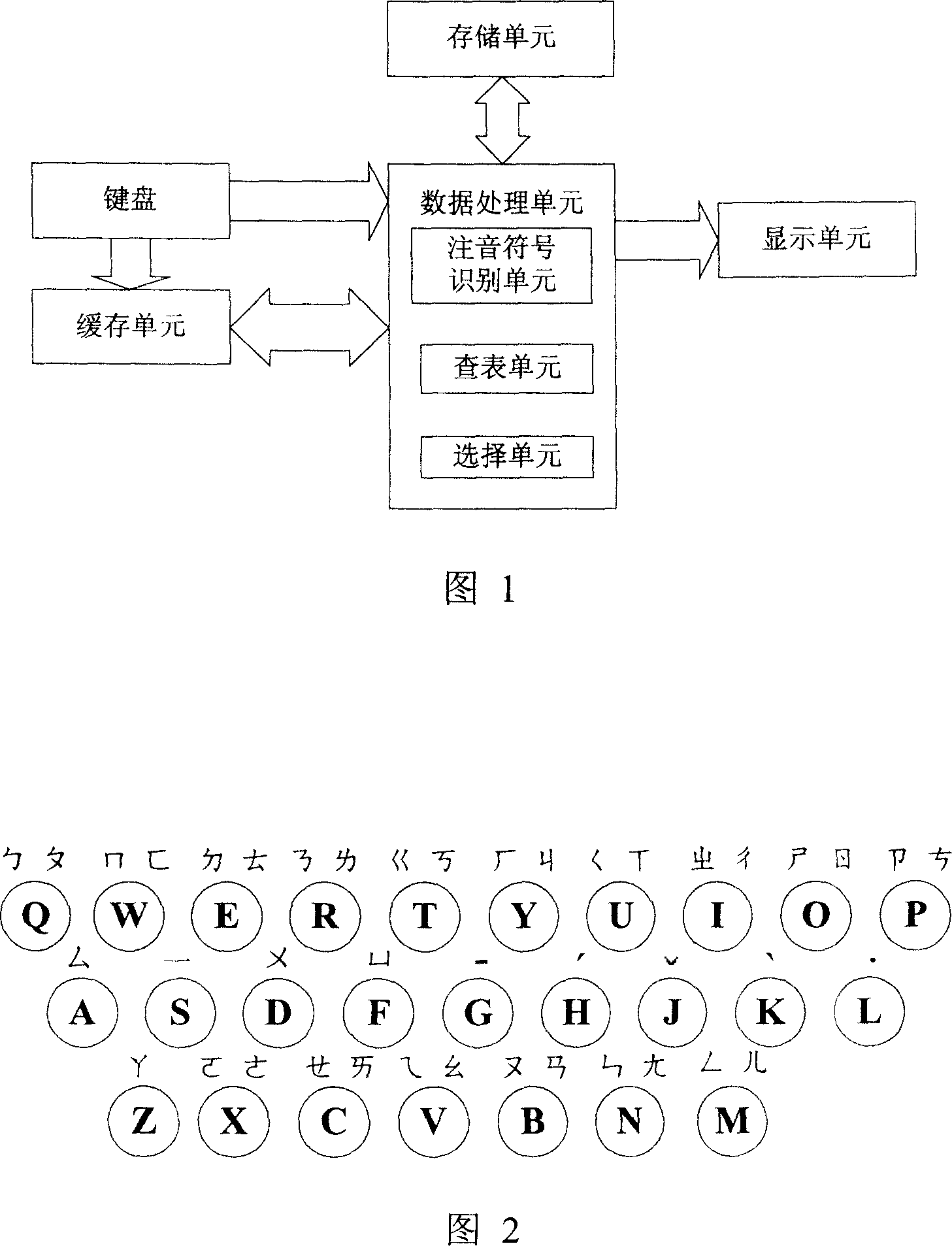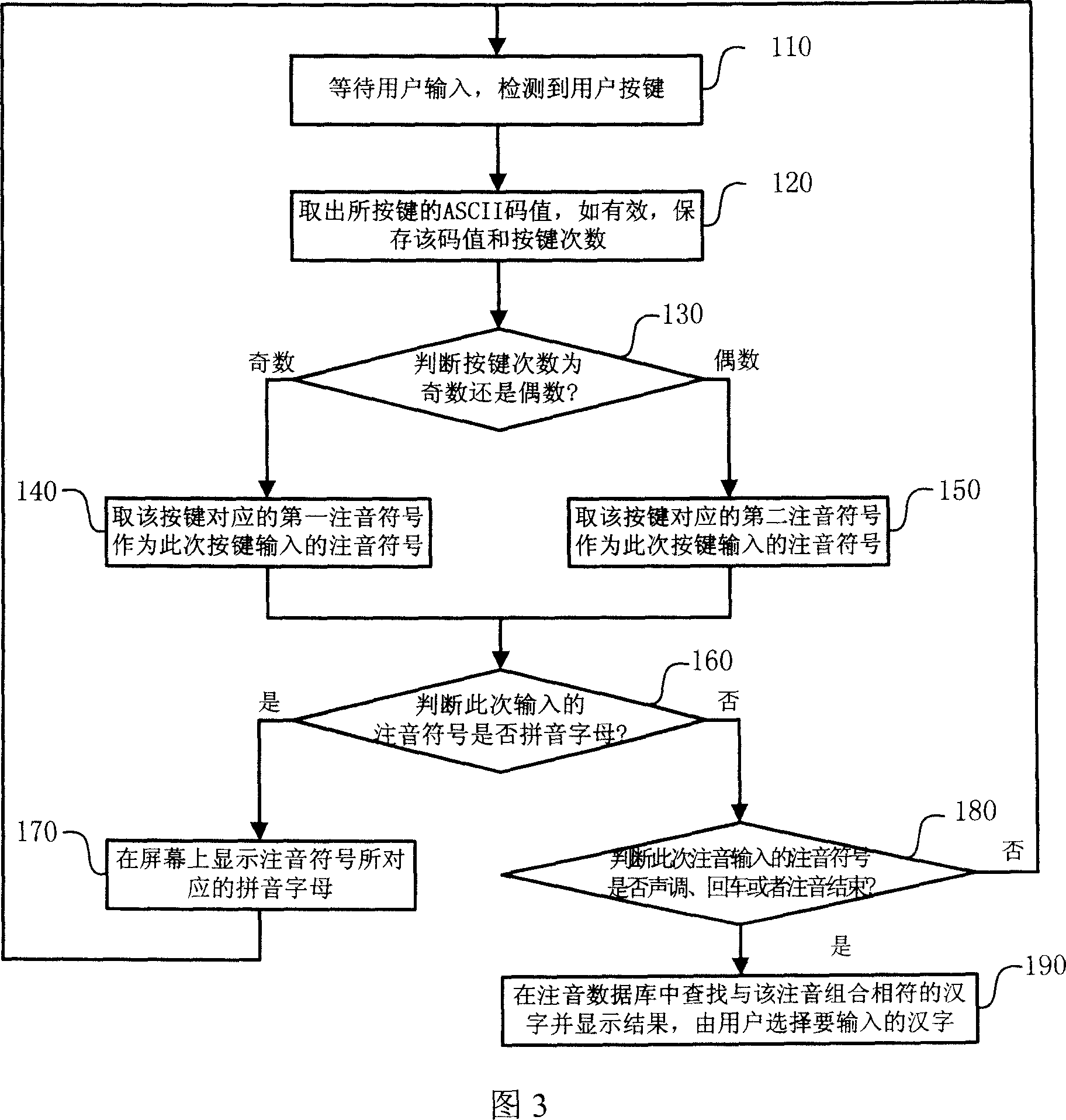Chinese phonetic notation input method and device thereof
An input method and technology of an input device, applied in the input/output process of data processing, instruments, electrical digital data processing, etc., can solve the problems of sequential arrangement, not much improvement, and no setting of tone keys, etc. The effect of faster typing and fewer keystrokes
- Summary
- Abstract
- Description
- Claims
- Application Information
AI Technical Summary
Problems solved by technology
Method used
Image
Examples
no. 1 example
[0042] Fig. 1 shows the functional block diagram of the Chinese phonetic notation input device of the present embodiment, comprises:
[0043] Keyboard: used for users to input phonetic symbols and tones of initials, medials and finals in sequence on the 26-letter keyboard.
[0044] Cache unit: used to cache the corresponding parameters (such as ASICII codes) of the phonetic symbols typed in.
[0045] Storage unit: used to store information about the correspondence between phonetic symbols and keys, control codes of phonetic input methods, and a phonetic database.
[0046] Data processing unit: It is used to determine the input phonetic symbols according to the key position of the user's key and the number of times the same key is pressed continuously, and at the same time control the buffer unit to store the corresponding parameters, and output after finding the matching Chinese character data. It further includes:
[0047] The phonetic symbol recognition unit is used for id...
no. 2 example
[0095] In this embodiment, all phonetic symbols and tones are assigned to the 26 letter keys in the original order and arranged in rows, but on the basis of the first embodiment, the positions of the keys corresponding to medial sounds, tones and finals are exchanged. As shown in Figure 4, the 26 letter keys are still roughly divided into three parts: the keys located in the first row of the standard keyboard correspond to the phonetic symbols of initial consonants; the keys located in the second row of the standard keyboard, except the K key and the L key respectively correspond to Except for the soft tone and initial consonant phonetic symbols, other keys correspond to final phonetic symbols; the keys located in the third row of the standard keyboard correspond to medial phonetic symbols and tones. The phonetic symbols on each row are still arranged from left to right according to their respective order.
[0096] The corresponding relationship between the letter keys of the ...
no. 3 example
[0100] In the present embodiment, all phonetic symbols and tones are still designated on the 26 letter keys according to the original order and are arranged in rows, and the buttons located in the first row of the standard keyboard correspond to the phonetic symbols of medial and final vowels; they are located in the second row of the standard keyboard The keys correspond to the initial phonetic symbols and tones; the keys on the third row of the standard keyboard correspond to the initial phonetic symbols. The phonetic symbols on each row are still arranged in sequence. specifically:
[0101] The letter keys O, W, E, R, T, Y, U, I, O, P in the first row are used for medial and final phonetic symbols "一", "ㄨ", "ㄩ", "ㄚ" in turn , "ㄛㄜ", "ㄝㄞ", "ㄟㄠ", "ㄡㄢ", "ㄅㄤ", "ㄥㄦ" input.
[0102] The letter keys A, S, D, F, G, H, J, K, and L in the second row are used in turn for the seven consonant phonetic symbols "ㄓㄔ", "ㄕㄖ", "ㄗㄘ", "ㄙ" , and the tones Yinping (-), Yangping ( ), the upper...
PUM
 Login to View More
Login to View More Abstract
Description
Claims
Application Information
 Login to View More
Login to View More - R&D
- Intellectual Property
- Life Sciences
- Materials
- Tech Scout
- Unparalleled Data Quality
- Higher Quality Content
- 60% Fewer Hallucinations
Browse by: Latest US Patents, China's latest patents, Technical Efficacy Thesaurus, Application Domain, Technology Topic, Popular Technical Reports.
© 2025 PatSnap. All rights reserved.Legal|Privacy policy|Modern Slavery Act Transparency Statement|Sitemap|About US| Contact US: help@patsnap.com



